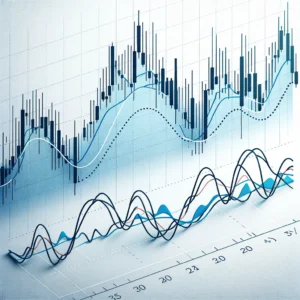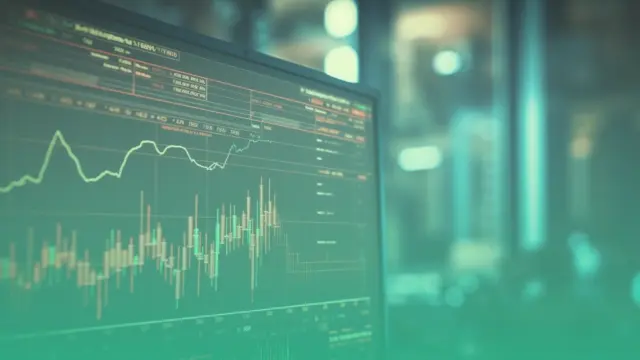Introduction
The world of trading is fast-paced, with traders always looking for ways to predict what will happen in the markets next. One key tool they use is called technical indicators. These are based on math and statistics and help traders guess where market prices might go in the future.
There are many types of technical indicators. Some, like moving averages, are simple and help smooth out price changes over time. Others, like the Relative Strength Index (RSI) and Bollinger Bands, are more complex and give insights into how fast prices are moving and how volatile the market is. These indicators are more than just numbers; they reflect what traders and the market are thinking and feeling.
The main idea behind using these tools is that what happened in the market before can give us hints about what might happen next. This is because market trends and patterns often repeat over time. Traders use technical indicators to spot these trends and patterns, which helps them make educated guesses about future market movements.
However, there are some challenges with technical indicators. Since they mainly look at past data, they might not always predict the future accurately. Also, different traders might interpret the same indicators in different ways, which can make it hard to be sure about their predictions.
Even with these challenges, technical indicators are very important for traders. When used carefully and together with other analysis methods, like studying a company’s fundamentals, they can really help traders make better decisions, manage risks, and find good trading opportunities.
Understanding Technical Indicators
Technical indicators are key tools for traders who want to predict where the market will go next. They use math to look at past prices and trading volumes of stocks (or other securities) to guess future movements. Think of these indicators as a way to understand market trends and where things might head.
These tools are like special formulas that take old market data and use it to give an idea of what might happen next with the prices. Traders use them a lot to decide when to buy or sell, and to understand if a market trend is strong or weak. They’re essential for making informed trading decisions.
Key Technical Indicators and Their Interpretation
Technical indicators are vital for traders looking to predict market moves. This part explains important indicators, what they do, and how traders usually understand them in analyzing the market.
Moving Averages (MA)
Moving Averages are fundamental tools in technical analysis, used to identify and confirm trends. They smooth out price data over a specific period, providing a clearer view of the price trend by reducing market noise.
- Simple Moving Average (SMA): Calculates the average of a selected range of prices, typically closing prices, over a specified number of periods.
- Exponential Moving Average (EMA): Similar to SMA but gives more weight to recent prices, making it more responsive to new information.
Relative Strength Index (RSI)
The RSI is a momentum oscillator that measures the speed and change of price movements. It oscillates between zero and 100 and is typically used to identify overbought or oversold conditions in the market.
- Overbought Conditions: An RSI reading above 70 suggests that a security might be overbought and could be primed for a trend reversal or corrective pullback.
- Oversold Conditions: An RSI reading below 30 indicates an oversold condition, signaling a potential upward turn in the security’s price.
Bollinger Bands
Bollinger Bands consist of a middle band being a moving average and two standard deviation bands above and below this middle band. They expand and contract based on market volatility.
- High Volatility: When the bands widen, it indicates increased market volatility.
- Low Volatility: Narrow bands suggest lower market volatility.
Fibonacci Retracements
Fibonacci Retracements are popular tools used to identify potential support and resistance levels based on key Fibonacci numbers. These horizontal lines are drawn at percentages of a price move (like 23.6%, 38.2%, 61.8%).
- Potential Reversal Points: Traders look for price reversals at these Fibonacci levels during retracements in a trend.
MACD (Moving Average Convergence Divergence)
The MACD is a trend-following momentum indicator that shows the relationship between two moving averages of a security’s price.
- Signal Line Crossovers: The MACD generates bullish signals when it crosses above its signal line and bearish signals when it crosses below the signal line.
- Divergence: MACD divergence from price indicates a potential end to the current trend.
These indicators offer special insights into how the market behaves and where prices might go next. Although no one indicator always gets it right, learning how to use these key tools correctly can really help traders make smarter decisions. Coming up, we’ll dive into how these indicators work in the real world, with practical examples.
Combining Indicators for Enhanced Predictions

In predictive trading, skillfully blending multiple technical indicators greatly improves the precision of forecasting market movements. This method, known as multi-indicator analysis, leverages a variety of indicators to confirm trends and signals, minimizing false predictions and bolstering trading strategies.
Traders diversify their analysis tools rather than depending on a single indicator, which may only offer a narrow perspective on market behavior. For example, combining a trend indicator like the moving average with a momentum indicator such as the Relative Strength Index (RSI) can verify the durability and strength of a trend. This multifaceted approach provides a fuller understanding of market trends.
Successful integration of indicators requires a deep knowledge of each tool’s unique features and functions. Moving averages, for instance, are great for spotting trend directions, while oscillators like the RSI or Stochastic Oscillator shed light on market momentum and possible turning points. Synchronizing the insights from these diverse indicators leads to more reliable trading decisions.
A practical strategy might involve using a moving average to spot an uptrend, then consulting the RSI for momentum confirmation. If the moving average indicates a consistent trend and the RSI shows ongoing strength without signaling overbought conditions, this could be a robust sign to initiate a trade.
Incorporating volume indicators, such as the On-Balance Volume (OBV), further strengthens analysis by linking price changes with volume, offering additional proof of trend support. An ascending OBV paired with a rising price trend indicates a solid and backed movement, reinforcing the bullish signals from other indicators.
Nonetheless, traders should beware of the complexities of using multiple indicators. Overloading on similar indicators can cause confusion and analysis paralysis. The aim is to select complementary indicators that offer unique, corroborating evidence, enriching the trading decision process with keyword-rich insights into market dynamics, trend validation, momentum analysis, and volume confirmation.
Advantages and Limitations of Technical Indicators
Advantages
Technical indicators are a fundamental component of predictive trading, offering several advantages that can significantly aid traders in their decision-making processes.
- Objective Analysis: One of the primary benefits of technical indicators is their ability to provide an objective basis for analyzing market trends and potential trade opportunities. Unlike subjective analyses, technical indicators rely on concrete market data, reducing personal biases in trading decisions.
- Trend Identification: Indicators like moving averages and MACD are incredibly useful in identifying market trends. They help traders understand whether a market is in an uptrend, downtrend, or moving sideways, which is crucial for deciding on entry and exit points.
- Momentum Assessment: Indicators such as the RSI or Stochastic Oscillator help traders gauge the momentum of a market. Understanding whether a market is gaining or losing momentum can be pivotal in predicting future price movements.
- Volatility Insights: Indicators like Bollinger Bands provide traders with a clear visual representation of market volatility. Higher volatility may present more trading opportunities but also comes with increased risk.
Limitations
Despite their numerous benefits, technical indicators are not without their limitations, and understanding these is key to using them effectively.
- Lagging Nature: Many technical indicators are lagging, meaning they are based on historical data. This can result in a delay in the signal, potentially leading to missed opportunities or late entries.
- False Signals: No indicator is perfect, and sometimes they can generate false signals. Relying solely on technical indicators without considering other market factors can lead to misguided trading decisions.
- Overreliance on Past Data: Technical indicators are based on historical market data, and there is no guarantee that past patterns will repeat in the future. Market conditions can change rapidly, rendering previous patterns obsolete.
- Complexity and Overuse: For new traders, the complexity and sheer number of available indicators can be overwhelming. Overusing indicators or misinterpreting their signals can lead to confusion and poor trading decisions.
Practical Tips for Traders Using Technical Indicators
To maximize the effectiveness of technical indicators in trading, it’s crucial to adhere to some practical guidelines. These tips can help traders navigate the complexities of using technical indicators and enhance their trading strategies.
Understand Each Indicator
Before using any technical indicator, it’s vital to understand how it works, what it measures, and its limitations. This knowledge will help in interpreting the signals more accurately and making informed trading decisions.
Start with a Simple Approach
For beginners, it’s advisable to start with a few basic indicators. Overcomplicating your strategy with too many indicators can lead to confusion and contradictory signals. A simple combination of a trend-following indicator and a momentum indicator can be a good starting point.
Use Indicators in Context
Always consider the broader market context when interpreting indicator signals. Factors like market news, economic events, and overall market sentiment should be taken into account as they can greatly influence the market.
Backtesting is Key
Before applying any new indicator or strategy in live trading, backtest it using historical data. This will give you an idea of how the indicator performs under different market conditions and help refine your strategy.
Avoid Signal Chasing
Don’t just jump into a trade based on a single indicator signal. Wait for confirmation from additional indicators or other forms of analysis. This helps in filtering out false signals and improves the reliability of your trading decisions.
Customize Settings
Most indicators come with default settings, but these might not be suitable for all markets or timeframes. Adjust the settings of your indicators to match your trading style and the specific characteristics of the market you are trading in.
Manage Risk
Even the best technical analysis cannot guarantee success in every trade. Implement sound risk management practices, like setting stop losses and only risking a small percentage of your capital on a single trade.
Continuous Learning
The markets are dynamic and constantly evolving. Continuously educate yourself about new indicators, strategies, and market changes. Staying informed and adaptable is key to long-term success in trading.
Integrate Fundamental Analysis
While technical indicators are powerful, they should not be the only tool in your trading arsenal. Integrating fundamental analysis can provide a more comprehensive view of the market and enhance your trading decisions.
Practice Makes Perfect
Finally, practice is crucial. Use demo accounts to practice your strategies using technical indicators without any financial risk. This hands-on experience is invaluable in building confidence and skill in using technical indicators effectively.
By following these tips, traders can utilize technical indicators more effectively, leading to improved decision-making and potential success in the markets. Remember, no single strategy fits all; each trader must find the combination of tools and strategies that best suits their individual trading style and goals.
In Conclusion
Technical indicators are crucial for traders, offering deep insights into the market and helping predict future price changes. They simplify complex market data into clear, actionable insights, becoming essential in predictive trading.
However, traders must understand that technical indicators aren’t perfect. They work best as part of a well-rounded trading strategy that includes understanding market dynamics, fundamental analysis, and strong risk management. Success in trading comes from using technical analysis wisely, knowing its limits, and being committed to ongoing learning and adjustment.
As discussed, each indicator has its own pros and cons, and using them together strategically can boost their effectiveness. But it’s important for traders to use these tools thoughtfully, adapting them to their own trading style and the market’s current state. Backtesting strategies and using demo accounts are key to getting good at using technical indicators.
In summary, while technical indicators are a powerful part of predictive trading, their real value comes from using them with discipline, deep market knowledge, and an understanding of the wider economic and financial context. As markets change, traders should also evolve their strategies, aiming for a more profound and refined use of these important analytical tools.





